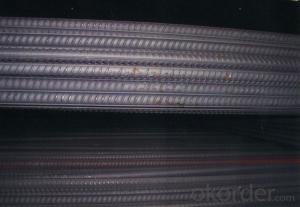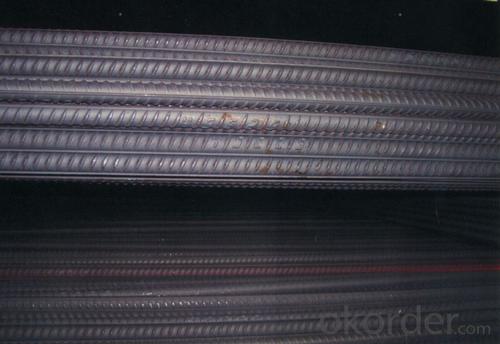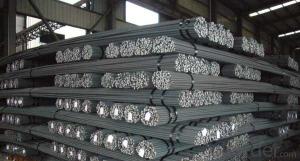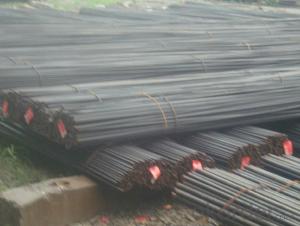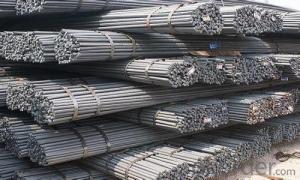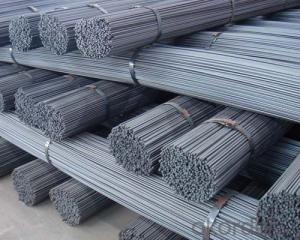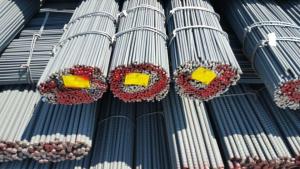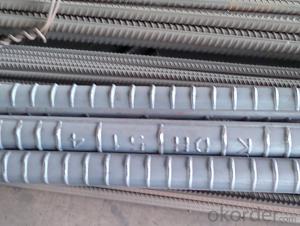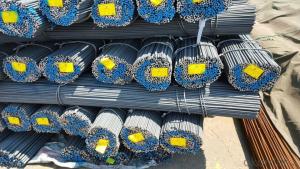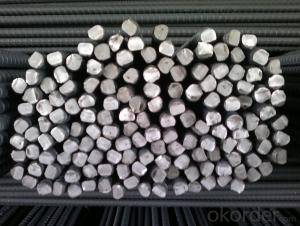Hot rolled ribbed steel bars (HRB400E~500)
- Loading Port:
- Tianjin
- Payment Terms:
- TT OR LC
- Min Order Qty:
- 1000 m.t.
- Supply Capability:
- 20000 m.t./month
OKorder Service Pledge
OKorder Financial Service
You Might Also Like
Reinforcing bar (Rebar) refers to the use of reinforced concrete and prestressed concrete with steel, its cross section is round, sometimes for the square with rounded corners. Including light round bar, ribbed steel bar, torsion bar. Reinforced concrete with steel bar is refers to the reinforced concrete reinforcement with straight or plate of strip steel, its appearance is divided into two kinds, light round steel and deformed steel delivery status for the straight bar and wire rod in two. Light round bar is really a small round steel and ordinary low carbon steel wire rod. Deformation is surface ribbed steel bar, usually with 2 longitudinal and cross rib of uniform distribution along the length direction. The appearance of cross rib is spiral, chevron, crescent 3 kinds. With nominal diameter mm number representation. Equals the nominal diameter is equal to the cross section deformation of reinforced light round bar nominal diameter. Reinforcement of nominal diameter is 8-50 mm, recommends to the diameter of 8, 12, 16, 20, 25, 32 and 40 mm. Steel grade: 20 mnsi, 20 mnsi MNV, 25, BS20MnSi. Rebar in concrete main tensile stress. Deformed bars as a result of the action of rib, and concrete have larger bonding ability, thus better able to withstand the role of external force. Steel is widely used in various building structures. Especially large, heavy, light thin wall and high-rise building structure.
Steel processing, steel processing to table and design review, check the material list for errors and omissions, for each steel bar to press
Material list to check whether meet the requirements, after these two checks, then press the material list sent out samples, trial production of qualified rear can batch production, processing and good reinforcement to neatly stacked in order.
Construction such as the need to be reinforced by substitution, must fully understand the design intent and substitution material performance, strictly abide by the current design code of reinforced concrete rules, not to area such as the substitution of low strength of high strength steel reinforcement. Any important parts of a reinforced substitution, shall agree with the consent of party a, design unit, and have a written notice shall be substitution.
(1) the steel surface should be clean, sticky oil, dirt, rust must be cleaned before use, can be combined with cold-drawn rust removal process.
(2) reinforced straightening, usable mechanical or manual straightening. After straightening of steel can not have local small bending, die bending, wavy, its surface scars should not be made of steel decreases by 5%.
(3) the steel bar cutting should be according to the number, diameter, length and quantity, the length is tie-in, first cutting long expected, by cutting short expected to reduce short head, and shorten the steel to save steel.
(4) steel hook or bend:
1) steel hook. There are three kinds of forms, respectively semicircle hook, hook and hook. After bending, bend endothelial contraction, skin
Extension, axis length is constant, bend arc formation, size is greater than the baiting size after bending, bending modifier should be considered.
Reinforced bending diameter of 2.5 d heart, straight part for 3 d. Steel hook increase the length of the theoretical calculation value: counter rotating round hook is 6.25 d, the straight
Hook is 3.5 d, the hook is 4.9 d.
(2) the bending of steel. Middle bending diameter D bend, not less than five times the diameter of the reinforcing steel bar.
(3) the stirrup. Stirrups should be done at the end of the hook, hook form should meet the design requirements. Stirrup adjustment, is the hook to increase the length and bending adjustment
Value or the difference between the two and, according to the amount of stirrup outsourcing size or inside the package size.
(4) reinforced blanking length should be according to the component size, concrete cover thickness, rebar bend modifier and hook to increase the length of the provisions as comprehensive exam
Lv.
A. straight reinforced blanking length = member length - protective layer thickness increase length + hook,
B. turn up steel blanking length = straight length - bend modifier + + inclined curved length increase length of hook,
C. blanking length = stirrup stirrup inner perimeter + modifier + hook to increase length of stirrup.
- Q: Can steel rebars be painted or coated for aesthetic purposes?
- Yes, steel rebars can be painted or coated for aesthetic purposes. Painting or coating steel rebars can help improve their appearance and blend them with the surrounding structures or environment. The paint or coating can be chosen to match the desired color or style, allowing the rebars to be seamlessly integrated into the overall design. Additionally, painting or coating the rebars can also provide a layer of protection against corrosion and extend their lifespan. However, it is important to note that the paint or coating used should be specifically designed for steel and capable of adhering well to the surface, ensuring durability and longevity.
- Q: Can steel rebars be used in wind turbine tower construction?
- Yes, steel rebars can be used in wind turbine tower construction. Rebars provide strength and structural support to the tower, ensuring its stability and ability to withstand strong winds.
- Q: Are steel rebars resistant to corrosion?
- Yes, steel rebars are resistant to corrosion.
- Q: What is the process of painting steel rebars?
- The process of painting steel rebars typically involves several steps. First, the rebars must be cleaned thoroughly to remove any dirt, grease, or rust. This can be done using various methods such as sandblasting, wire brushing, or chemical cleaning. After cleaning, a primer is applied to the rebars to promote adhesion and corrosion resistance. The rebars are then left to dry before the final coating of paint is applied. This final coat can be either a solvent-based or water-based paint, depending on the desired finish and environmental considerations. The rebars are left to dry and cure, and once the paint is fully dried, they are ready to be used in construction projects.
- Q: Can steel rebars be used in structures subjected to extreme temperatures?
- Yes, steel rebars can be used in structures subjected to extreme temperatures. However, it is important to consider the specific grade and composition of the steel and the temperature range it can withstand without losing its structural integrity. Additionally, certain precautions and appropriate design considerations may be necessary to ensure the performance and durability of the steel rebars in extreme temperature conditions.
- Q: Are steel rebars suitable for use in structures with high wind loads?
- Yes, steel rebars are suitable for use in structures with high wind loads. Steel rebars provide strength and reinforcement to concrete structures, making them more resistant to high winds and ensuring the overall stability and durability of the structure.
- Q: What are the different types of steel rebars used in railway bridges?
- There are several types of steel rebars used in railway bridges, each with their own specific characteristics and applications. Some of the common types include: 1. Carbon Steel Rebars: These are the most commonly used rebars in railway bridges. They are made of carbon steel and provide high tensile strength and excellent durability. Carbon steel rebars can withstand heavy loads and are suitable for various railway bridge applications. 2. Stainless Steel Rebars: Stainless steel rebars are highly resistant to corrosion and are used in railway bridges located in coastal or high humidity areas. They offer excellent long-term performance and are particularly beneficial in preventing rust and deterioration caused by exposure to moisture and salt. 3. Galvanized Steel Rebars: Galvanized steel rebars are coated with a layer of zinc to enhance their corrosion resistance. They are commonly used in railway bridges in areas with aggressive environmental conditions, such as industrial zones or areas prone to chemical exposure. The zinc coating provides an additional protective barrier, increasing the rebars' lifespan. 4. Epoxy-Coated Steel Rebars: Epoxy-coated rebars are coated with a layer of epoxy resin, providing enhanced corrosion protection. They are commonly used in railway bridges exposed to harsh environments, such as bridges located near chemical plants or in heavily polluted areas. The epoxy coating acts as a barrier against corrosion and extends the rebars' service life. 5. Prestressed Steel Rebars: Prestressed steel rebars are designed to withstand high tension loads. They are used in railway bridges that require additional strength and stability, particularly in areas with heavy train traffic or where long spans need to be covered. Prestressed rebars are tensioned before the concrete is poured, allowing them to counteract the tensile forces and prevent cracking or deformation. These are just a few examples of the different types of steel rebars used in railway bridges. The choice of rebar type depends on various factors, including the environmental conditions, load requirements, and design specifications of the bridge. It is essential to select the appropriate type of rebar to ensure the structural integrity and longevity of railway bridges.
- Q: What are the different types of steel rebars used in precast concrete constructions?
- There are several types of steel rebars commonly used in precast concrete constructions, including plain round bars, deformed bars, epoxy-coated bars, stainless steel bars, and galvanized bars. Each type offers specific properties and advantages depending on the project requirements and environmental conditions.
- Q: How long do steel rebars last in structures?
- Steel rebars can last for several decades in structures, typically ranging from 50 to 100 years, depending on various factors such as the quality of the steel, environmental conditions, and maintenance practices.
- Q: How do steel rebars affect the overall cost-effectiveness of a structure?
- The overall cost-effectiveness of a structure is greatly improved by the presence of steel rebars. These reinforcement bars are extensively used in construction projects to provide concrete structures with strength, durability, and stability. By incorporating steel rebars, the lifespan of a structure is significantly extended, resulting in reduced requirements for frequent repairs and maintenance, ultimately lowering long-term expenses. One of the main advantages of using steel rebars is their ability to reinforce concrete, enabling it to withstand heavy loads and forces. This reinforcement prevents cracks and structural failures, ensuring the long-lasting nature of the structure. Consequently, the need for expensive repairs and replacements is minimized, resulting in cost savings over the structure's lifetime. Furthermore, steel rebars enhance the overall structural integrity of a building, reducing the risk of damage caused by natural disasters such as earthquakes and high winds. This increased resilience not only saves lives but also reduces the financial burden of rebuilding or repairing a damaged structure. In addition to their strength and durability, steel rebars provide cost-effectiveness during the construction phase itself. These bars can be prefabricated off-site, allowing for efficient and streamlined construction processes. This reduces labor costs, accelerates construction timelines, and minimizes material wastage, leading to overall cost savings. Moreover, steel rebars can be recycled, making them an environmentally friendly choice. The recycling process not only reduces the demand for raw materials but also lowers production costs, contributing to the cost-effectiveness of a structure. In conclusion, steel rebars enhance the cost-effectiveness of a structure by increasing its lifespan, reducing maintenance and repair costs, improving resilience to natural disasters, optimizing construction processes, and promoting environmental sustainability. By incorporating steel rebars into construction projects, developers and owners can maximize the return on investment while ensuring the safety and longevity of the structure.
Send your message to us
Hot rolled ribbed steel bars (HRB400E~500)
- Loading Port:
- Tianjin
- Payment Terms:
- TT OR LC
- Min Order Qty:
- 1000 m.t.
- Supply Capability:
- 20000 m.t./month
OKorder Service Pledge
OKorder Financial Service
Similar products
Hot products
Hot Searches
Related keywords
